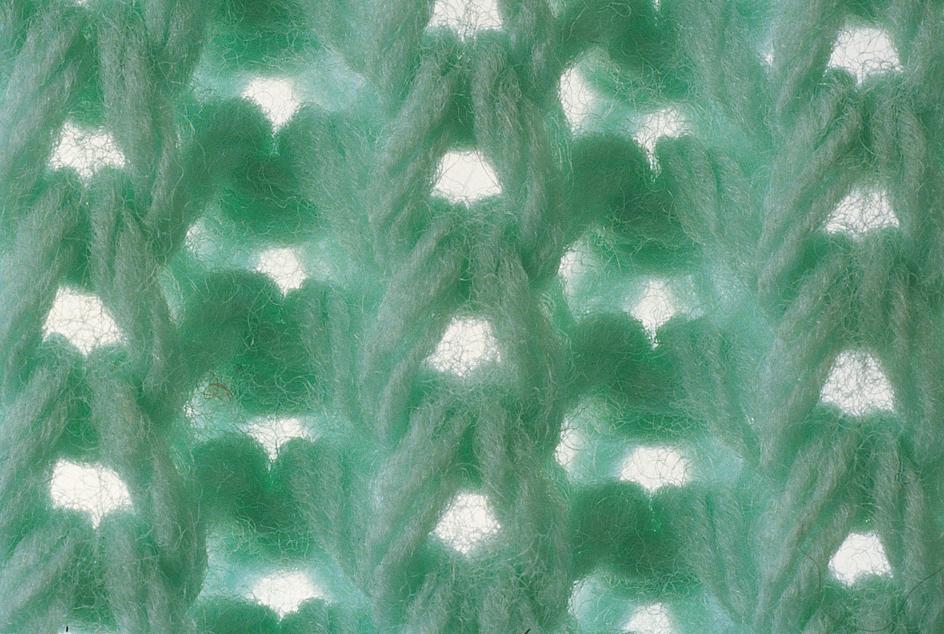Knitting is a method of making fabric by looping yarns around each other using one or more knitting needles. Much of the clothing we wear is made by knitting, including sweaters, stockings, scarfs, and hats. Knitted clothes are popular because they can stretch and then return to their original shape. A knitted fabric can be formed to create such items as wallhangings and stuffed fiber sculpture. Knitting can also decorate other fiber forms made by crocheting, macrame, and weaving. Knitting may be done by hand or by machines. This article describes hand-knitting. See also Knitting machine ; Textile (Knitted fabrics) .

Materials.
Most knitting needles are 7 to 14 inches (17.8 to 35.6 centimeters) long. One end is pointed, and the other end has a knob to prevent the fabric from slipping off. The earliest knitting needles had a hook at one end. They were probably made of twigs, pieces of bone, or copper wire. Today, knitting needles have smooth tips and are generally made of aluminum, wood, or plastic. The thickness of the needles and the type of yarn can be varied according to the nature of the fabric desired. Slender needles and lightweight yarn may be chosen for a delicate knit. Thick needles and heavy yarn produce a bulky knit. Wool has been the traditional yarn for knitting, but cotton, silk, and synthetics such as acrylic have also become popular. Blended yarns of two or more different fibers add to the variety.
Knitting with two needles produces a flat fabric. Three or four needles with points at both ends are used to create tubular pieces for socks and skirts. Knitters may also use circular needles and knitting spools.
Knitting the fabric.
Most knitting is done with two needles. The fabric is made by wrapping a series of looped threads around one needle in a required number. This is called casting on. The second needle is inserted into one or two loops at a time, and the yarn is wrapped around in a certain way. The stitch is made when the loop is passed onto the second needle.
The two basic stitches are the knit and the purl. There are many additional stitches, and hundreds of methods of combining the stitches to add variety to the fabric. One of the most popular stitch patterns is the rib stitch. This is often used at the bottoms, cuffs, and necklines of sweaters. Another common decorative stitch is the cable stitch. Knitting with various colors and textures of yarns adds interest to the designs. Knitted fabric is shaped by increasing or decreasing the number of stitches.
Most knitters follow written patterns that contain a standard vocabulary of abbreviations. A pattern gives directions on the types of stitches used, the order in which they are used, and the size and shape of the finished piece of fabric.
The knitter usually makes a sample about 3 inches (8 centimeters) square to determine the gauge. The gauge is the exact number of stitches and rows per inch produced by the needles, yarn, and type of stitch. Knowing the gauge is essential when sizes are required for clothing because each person’s hand-knitting differs in tension. If the knitted sample does not match the pattern gauge, the knitter must either change the needle size or the thickness of the yarn. This will assure the proper finished size of the garment. If the gauge measure is too large, a smaller needle or a thinner yarn is required. If the gauge measure is too small, a larger needle or a thicker yarn needs to be used.
History.
The origin of knitting is not known, but the craft has been practiced by many cultures for centuries. Knitting probably began about A.D. 200 in Arabia. As neighboring peoples traded with the Arabs, the technique gradually became known to much of the ancient world over the next few hundred years.
Peoples of the Middle East taught Europeans how to knit during the 600’s. Knitting guilds (workers’ unions) were soon formed throughout Europe, and for the rest of the Middle Ages, knitting was considered as much an industry as weaving. Knitters had to serve as apprentices for six years before they could enter a guild. Knitters also had to prove their ability to knit stockings, berets, shirts, and after 1602, elaborately designed carpets.
The Spanish carried knitting to South America and Central America in the 1500’s, but this art may have already been known by some people there. In Spanish American cultures, knitting became a popular and practical pastime for the peasants.
In cold climates, knitting has always been an essential way of creating warm clothing. Some examples are the knitted hats of the Peruvians in the Andes Mountains and the fisherman’s sweaters of Ireland.
